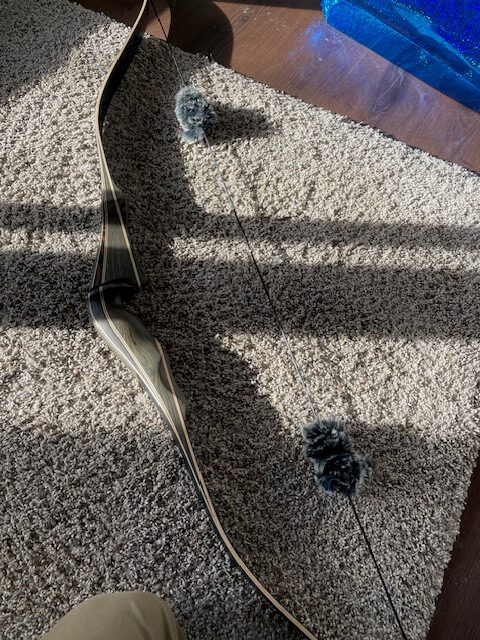
“Silence is a true friend who never betrays.” ~Confucius
Two of the best modifications that you can make to a traditional bow, that is, a longbow or in this case a recurve, are the addition of a nocking point and string silencers. Indeed, some archers don’t even consider them mods but essential processes that are central to bow set up.
At any rate, this short post will take you through the basics of how to install both of them on your string. My bow in question is a Buck Trail Antelope, 50 pounds, with an endless loop bowstring. The bow came with a flemish twist bowstring that I think (I can’t remember for sure) was an AMO 60, which means its actual length was 58.5.
Whatever the case, that bowstring was comically oversized, to the point that brace height was like 4” when the bow was strung (not an exaggeration).
So I set it up with an AMO 58 endless loop string that was actually 55.5” or 56” (I didn’t measure). Either way, that fixed the brace height issue (as you can see in the image below), but that left me with a string that lacked a nocking point and silencers, ergo the need for this post.
How to Install a Nocking Point
To install a nocking point, you will need 4 things: the nocking point itself, nocking point pliers, and a T-square.
First, string your bow and clip the T-square onto the serving. Slide it down until it just barely touches the riser’s shelf, as shown in the image below.
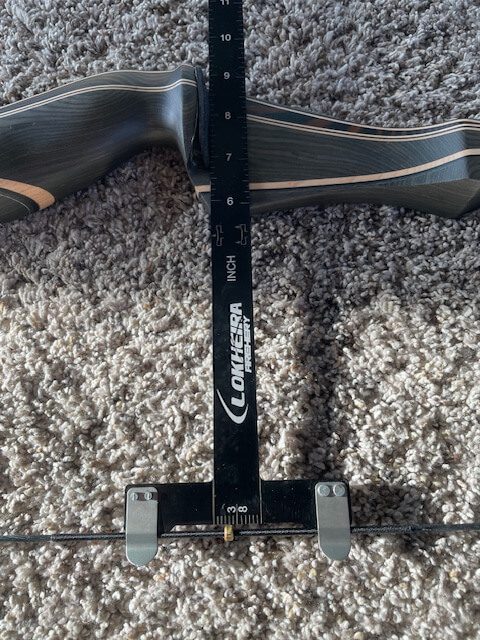
As you can see, brace height is set here at just about 7.5”. I’d prefer 8” but this will do.
The bottom of the bow T-square is where the arrow will actually rest on the shelf, so you want to start where it shows ⅜” on the T-square, and count two either 2/8” or ⅜” from that point.
I shoot split finger, which means my middle finger and ring finger sit below the nock and my index finger above it. For most split-finger shooters, they place the nocking point on the serving just above where the nock will be.
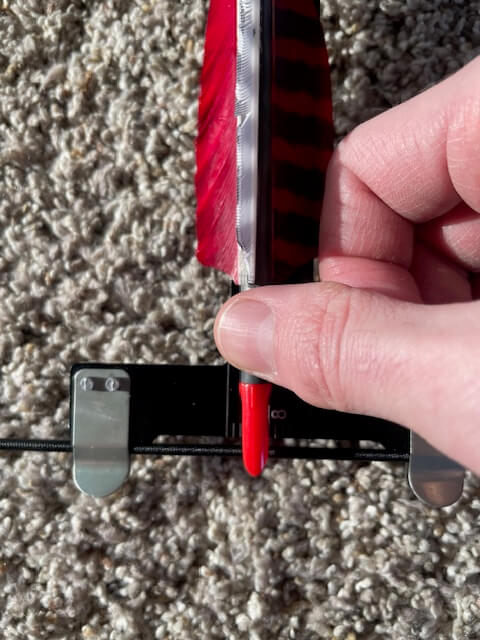
Some shooters install a point above and below the nock, but that’s just wasteful. I only need one. As long as you remember to nock just beneath the nocking point, you’re good.
Take your nocking point, and slide it onto the string so that it’s 2/8” to ⅜” below the mid-marking on the T-square tool, then pinch it into place with your nocking pliers.
From here, you can use the jaws of the nocking pliers to fully crimp down on the nocking point.
How to Install String Silencers
Next up, we want to install string silencers on our bow string. There are plenty of good reasons to install silencers on a bowstring (which I will cover below). For me, it’s gotten to the point that I will not shoot a recurve or traditional bow without silencers because of the dampening effect they offer.
Anyway, there are two main types of silencers for traditional bowstrings. One is made of thin rubber strands and these are usually referred to as cat whiskers. I have these on one of my bows, and the good news is that they are crazy easy to install. You just tie the rubber strands in a knot on the bowstring and then separate the fibers.
However, in my experience, though these do work, they don’t offer the same performance as traditional silencers which are made of real fur. Commonly, beaver, otter and rabbit fur are used to dampen bowstrings. I think the ones I installed were rabbit fur; either they are, or they’re synthetic, but it’s a good fake.
Either way, what you want to do is install the silencers about halfway between the serving and the respective ends of the string. Each bow has unique harmonics properties and there is an ideal place where you should be installing the silencers, but for the purpose of this exercise, my method will work just fine.
So, string the bow, then using your string separator, open up the fibers. Ideally, you want to separate the fibers exactly at the midpoint. This is easier with a flemish twist bowstring since the two-tone nature makes identifying the exact midpoint of the string easier. On an endless loop string, you’ll just need to eyeball.
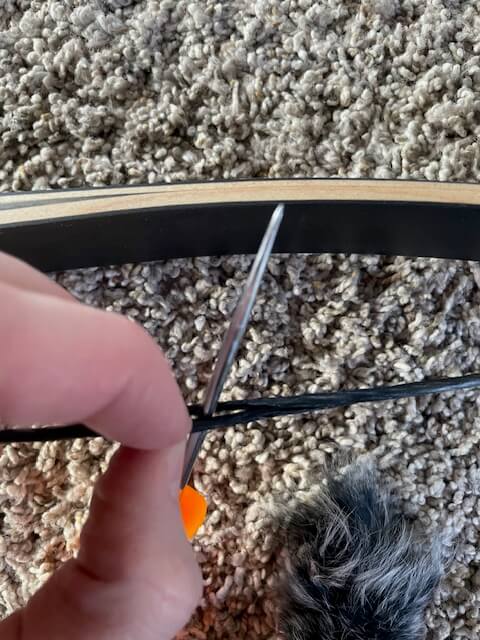
Now, this is important; it is absolutely critical that you don’t use anything sharp to separate the bowstring. Damage to your bowstring isn’t just dangerous to your bow, it can be dangerous to you. Be very careful when separating.
Once you have the fibers opened, slip one end of your silencer in there. Remove whatever you use to separate the fibers so that the string clamps back down on the silencer.
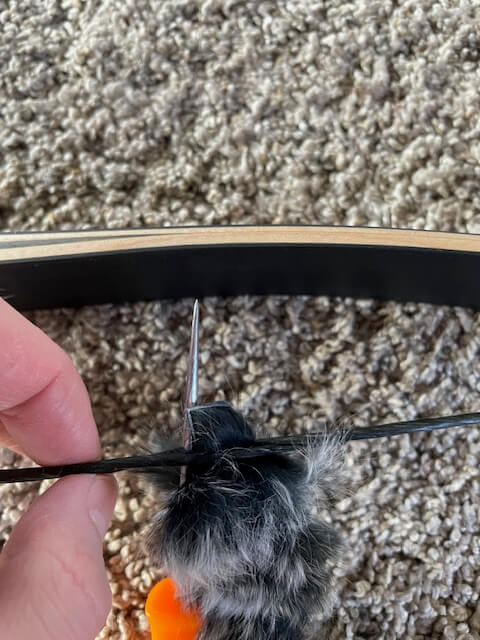
Now, you want to wind your silencer around your bowstring in a spiral, in sort of a barberpole configuration. Once you get to the end, re-open the bowstring’s fibers and stick the tag end of the silencer in there.
Remove the string separator so the string clamps down on the silencer, and you’re set. You should be able to slide the silencer up or down slightly on the string from this point to complete the install.
Anyway, with your silencers first installed, they might look a little dishevelled and ratty, but that’s alright – once you send a few arrows downrange, absorbing all that vibration will fluff the silencers out. They’ll look much more polished after a few trips to the range.
Note: For bows of a certain poundage, it can be impossible to separate the fibers adequately enough, with the bow strung, to get the tag end of the silencer installed. If that is the case, start the installation, and then unstring the bow to slip the remaining end of the silencer through the strands before restringing the bow to complete the install.
One more thing: Once you install string silencers and shoot with them, they should stay in place on the string even when you unstring the bow, which is a nice bonus. They’re a bit of a headache to get on there, but once you’re good, they usually stay put, especially once you wax the string.
Why Install a Nocking Point?
There are bows out there with servings that lack nocking points, but personally I would not shoot one of those. The nocking point tells you at a glance, instinctively, where to nock your arrows. Not only can you shoot more quickly and more accurately with a nocking point installed, but the nocking point prevents you from nocking too high or too low, which will result in porpoising.
An arrow is said to “porpoise” when it fishtails vertically as it flies. This can in theory occur when an arrow lacks appropriate spine (is not stiff enough) for a bow, but more often than not, it happens when you nock the arrow too high or too low.
The solution (assuming you have arrows of appropriate spine) is simple. Just install a nocking point at the right height on your serving so your arrows fly true off the shelf.
Why Install String Silencers?
As important as a nocking point is to accuracy, I cannot stress enough how important string silencers are. They are not just there to look cool, even if they do.
First, for hunters, string silencers considerably cut back on the noise produced by the bow. I’ve shot some pretty noisy, downright loud recurves and longbows in my day, and the best thing you can do to shut them up is to silence the strings. This makes the bow not just more enjoyable to shoot at the range, but also gives you an advantage in the field, as a quieter bow will incur lower chances of a jumped string – that is, you’ll be more surreptitious in the woods and less likely to spook your target species.
Most importantly, however, is this: a silenced string protects the bow itself.
I have one particularly noisy longbow that I shot a few times without silencers. The riser started to delaminate on me. I installed silencers, and vibration dropped to near-zero. At least, I couldn’t feel it anymore, and the delamination appeared to stop progressing.
The point is, silencers absorb a significant amount of vibration that can potentially harm your bow. If for no other reason, this is why you should install silencers on your string.
Now, there’s just one thing to keep in mind with string silencers. They do technically slow down your bow just a bit, but we’re talking a handful of FPS at most. All in all, the upgrade is worth it.
Be safe.
~The Eclectic Outfitter